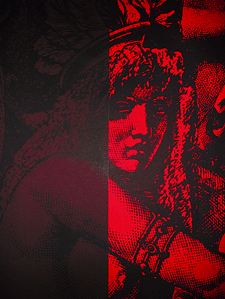Five arts challenge notions of sexuality, gender and power at Paul Sharpe
ASSumptions, a group exhibition of five artists, examines gender, sexual identity, power and representation. The show’s organizing principle points to the wild assumptions that stem from stereotypes and fearful desires for conformity and control, a timely notion during growing assaults by radical right-wingers upon the social and cultural institutions of an open society. Each artist utilizes different tactics in their work; some are poetic while others are transgressively political.
Aaron Miller and Linda Cummings subvert the straight male-dominated arena of professional sports. Miller’s work “Players” includes baseball jerseys embroidered with pink triangles and emblazoned with words like Nancy Boy. The approach is in some ways anachronistic and reminiscent of Cary “Candyass” Leibowitz’s personalized and self-deprecating work of the early 1990s. But Miller’s work seems more political than tongue-in-cheek, pointing out the inequities of the queer closet prevalent throughout professional sports. Queer umpire David Pallone’s autobiography “Behind the Mask” certainly reveals the open hostility he faced in Major League baseball. Yet queer culture manages to insert itself into our national pastime. Nearly three decades after the release of the Village People’s “YMCA,” the song is played at ball parks across America, an ironic, unwitting celebration of gay male sexuality.
More subtly Linda Cummings’ poetic work undermines power inherent in the arena of the spectacle. Her photographs of a woman’s undergarment floating in the wind over empty stadiums are a fascinating exploration of feminine power being imposed on the realm of public spectacle. The visual effect is ghostly and evokes both absence and the transcendence of power.
Robert Appleton’s work captures the response to gender ambiguities with his drawing installation “Inference (Kiki And Herb Will Die For You).” He asked his students to draw and write their reactions to a photograph of the gender-bending performers Kiki and Herb. Eight out of ten of the responses identified Kiki as a man in drag, with other statements such as “the man is soft and ugly,” “gay,” “faggots” and “stupid.” In one particular child’s drawing, the character Kiki is shown being decapitated.
Juana Valdes and Aaron Krach approach their narratives on identity through a more personal lens. Valdes has created a stunning group of silk screened prints of neoclassical women. These colorful graphic images are a response to the demands of the traditional male gaze, which disallows female self-representation, making it unauthorized and illegitimate except as vehicles of desire and pleasure. This work undermines the primacy of that gaze through the dissection of anatomical parts and the use a saccharine palette of home décor paints with names such as “Sweat Pea.” The effect is a powerful series of iconic images that resonate with meaning.
Krach’s installation of self-scented candles accompanied by a poster documenting him swabbing his bodily fluids and flesh to distill the aroma into wax candles is an amusing and poignant moment that plays on visual and aromatic memory. There is a ceremonial quality to the candle relics and the photographic tapestry of annotated images.
The visual discourse in this exhibition attempts to identify forms of personal narrative in opposition to the prevailing modes of social, historical and political power that turn out to be less heavy-handed than one might first assume. There is a utility to the exhibition that perhaps is what makes it such a success in provoking awareness of the elusive quality of identity and power. The works effectively serves as vehicles for minority opinion in opposition to a deafening majority.
gaycitynews.com




































